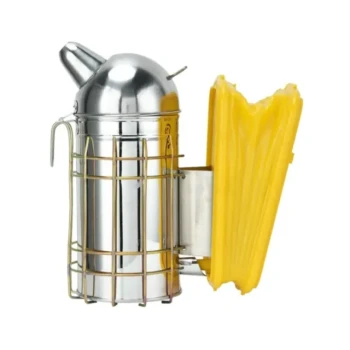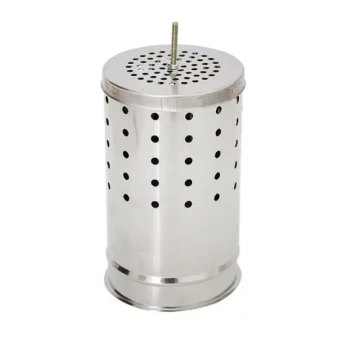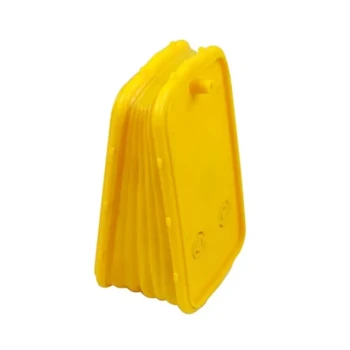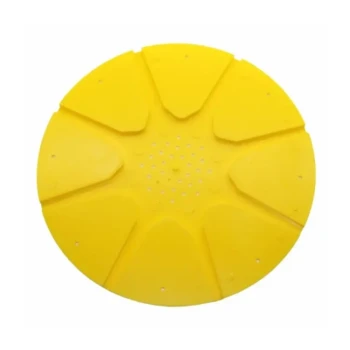When selecting a bee smoker, the critical factors to evaluate are the material and size of the fire chamber, the quality and durability of the bellows, and the presence of essential safety features like a heat shield. These components directly determine the smoker's effectiveness, longevity, and your safety during hive inspections.
A quality bee smoker is more than just a tool; it's a reliable partner in calm, effective hive management. The key is to look beyond the basic function and choose a model whose construction, capacity, and safety features align with the scale of your apiary and your personal workflow.
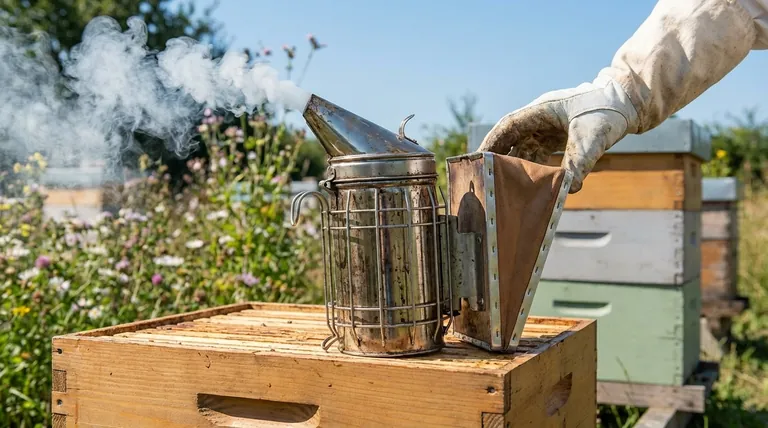
Deconstructing the Bee Smoker: Core Components
To choose the right smoker, you must first understand its fundamental parts and why their quality matters. A smoker is a simple machine, but small differences in construction have a significant impact on its performance.
The Fire Chamber: Material and Durability
The fire chamber, or firebox, is the heart of the smoker. Stainless steel is the standard material for a reason: it's durable and resistant to rust and corrosion.
Look for models with welded seams rather than crimped ones. Welded construction provides superior longevity and can withstand the constant heating and cooling cycles a smoker endures.
The Fire Chamber: Size and Capacity
Smoker size determines how long you can produce smoke before needing to refuel. Sizes are typically given as diameter by height (e.g., 4 x 7 inches).
A standard 4x7 inch smoker is suitable for many hobbyists. However, if you manage multiple hives or perform long inspections, a larger 4x10 or 4x11 inch model provides superior smoke generation and reduces the risk of running out of fuel mid-task.
The Bellows: Your Engine for Smoke
The bellows pump oxygen into the fire chamber, keeping the fuel smoldering and producing cool, white smoke. The quality of the bellows is often what separates a reliable tool from a frustrating one.
Check for durable materials like thick leather or high-quality vinyl. Ensure the bellows are securely attached to the wooden plates and that the assembly feels robust and capable of being operated easily, even with gloves on.
Internal Design: The Importance of Airflow
Effective smoke production depends on good airflow. A quality smoker will include a perforated plate or inner stand at the bottom of the fire chamber.
This grate elevates the fuel off the bottom, allowing air from the bellows to circulate underneath it. This design ensures a more consistent, complete, and cooler burn.
Essential Safety and Convenience Features
Beyond the core components, specific features are designed to protect you from burns and make the tool easier to handle.
The Heat Shield (Cage)
A smoker's exterior gets extremely hot. A heat shield, or wire cage, that surrounds the fire chamber is a non-negotiable safety feature. It creates a critical barrier between your hands and the hot metal surface.
Ensure the cage is sturdy and securely welded to the smoker body, providing complete protection.
The Mounting Hook
A simple hook attached to the side of the smoker is an invaluable convenience feature. It allows you to hang the smoker on the side of a hive box or your belt, freeing up your hands during an inspection.
Understanding the Trade-offs and Risks
Choosing a smoker involves balancing competing factors. Understanding these trade-offs ensures you select a tool that truly fits your needs without introducing unnecessary risk.
Size vs. Portability
While a larger smoker offers longer burn times, it is also heavier and more cumbersome. For a beekeeper with only one or two hives, a smaller, more maneuverable smoker may be the more practical choice.
Cost vs. Longevity
Inexpensive smokers can be tempting, but they often use thinner metal, weaker bellows, and crimped seams that fail over time. Investing in a well-constructed, welded stainless steel smoker will almost always prove more economical in the long run.
The Inherent Risk: Heat and Fire
Always treat your smoker with respect. Ensure the fire is completely extinguished before storing it, and never leave a hot smoker on a flammable surface. The metal remains dangerously hot long after the smoke has stopped.
Making the Right Choice for Your Apiary
Select your smoker based on a realistic assessment of your beekeeping goals and the size of your operation.
- If you are a hobbyist with 1-3 hives: A standard 4x7 inch stainless steel smoker with a good heat shield is an excellent and sufficient choice.
- If you manage a larger apiary (4+ hives) or prefer long inspections: Invest in a larger 4x10 or 4x11 inch model to ensure you have consistent smoke without refueling.
- If safety and durability are your top priorities: Prioritize a model with fully welded seams, a robust heat cage, and high-quality leather bellows, even if it costs more upfront.
Ultimately, the best bee smoker is a durable, safe tool that feels like a natural extension of your hand during hive inspections.
Summary Table:
| Key Factor | What to Look For | Why It Matters |
|---|---|---|
| Fire Chamber Material | Welded stainless steel | Durability, rust resistance, longevity |
| Fire Chamber Size | 4x7" (hobbyist), 4x10"+ (commercial) | Burn time, fuel capacity for hive count |
| Bellows Quality | Thick leather or high-quality vinyl | Consistent smoke, ease of use with gloves |
| Safety Features | Sturdy heat shield/cage, mounting hook | Burn protection, hands-free convenience |
| Internal Design | Perforated plate for airflow | Cooler, consistent smoke production |
Equip Your Apiary with Professional-Grade Smokers from HONESTBEE
Choosing the right bee smoker is critical for the safety and efficiency of your hive inspections. At HONESTBEE, we specialize in supplying durable, reliable beekeeping equipment designed for the demands of commercial apiaries and distributors. Our wholesale-focused operations ensure you get the best value on high-performance smokers built with welded stainless steel chambers, robust bellows, and essential safety features.
Let us help you streamline your operations with equipment you can trust. Contact our team today to discuss your needs and explore our full catalog of professional beekeeping supplies.
Visual Guide
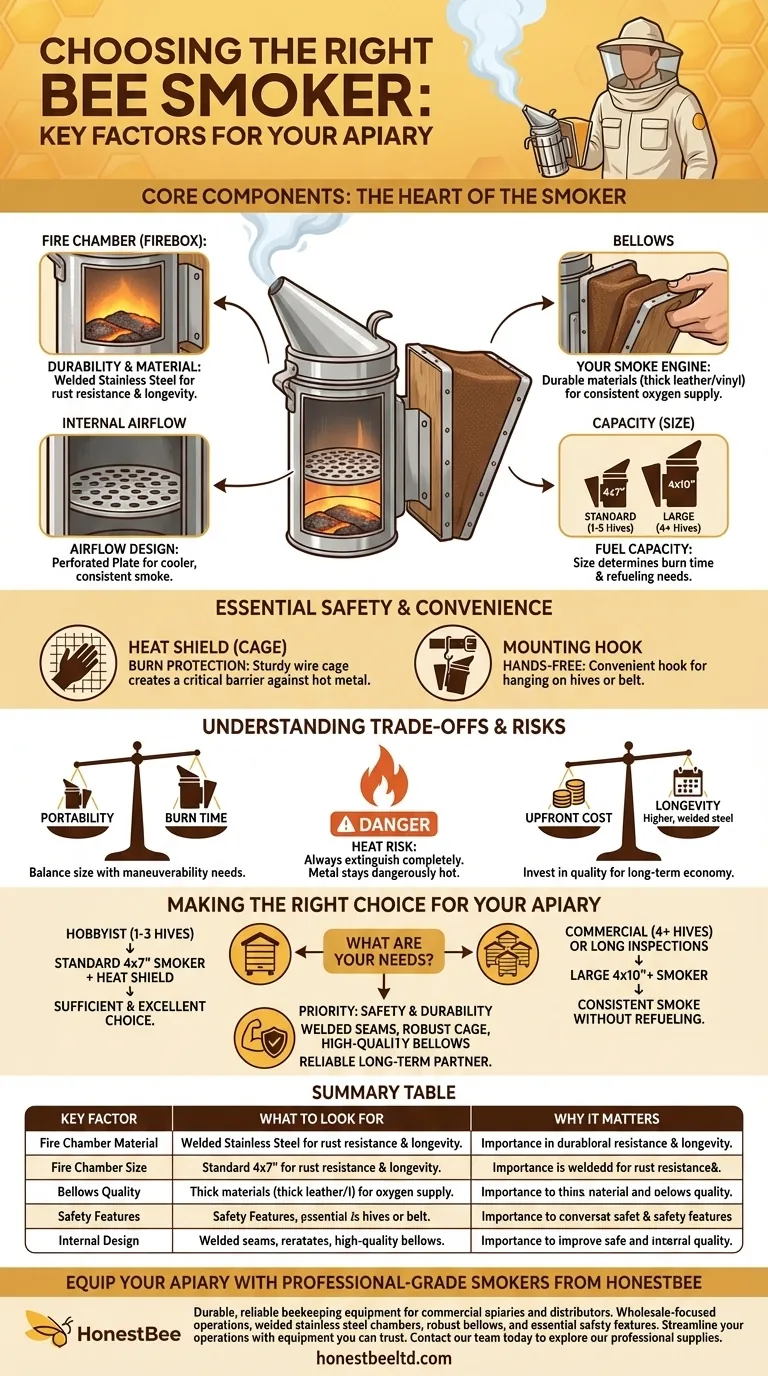
Related Products
- European Stainless Steel Bee Smoker for Honey Bee Hive
- Premium Traditional Copper Bee Smoker with Bellows
- Heavy-Duty Bee Smoker with Durable Plastic Bellows for Beekeeping
- Professional Bee Smoker with Elongated Spout and Durable Bellows for Beekeeping
- Heavy Duty Manual Bee Smoker Blower for Beekeeping
People Also Ask
- What are the advantages of a high-quality bee smoker? Achieve Calm, Confident Hive Management
- What are the key benefits of using a bee smoker? Master Hive Inspections Safely and Efficiently
- How does a smoker help during hive inspections? The Key to Calm, Safe Beekeeping
- What are the benefits of cleaning a bee smoker? Ensure Hive Safety and Bee Health
- What are the benefits of smoking bees? Achieve Safer, Calmer Hive Inspections


